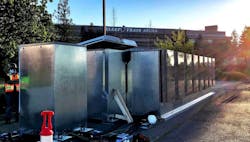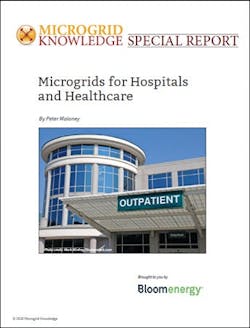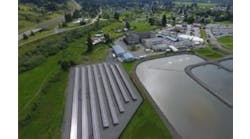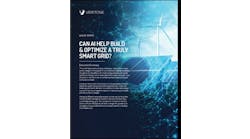What is the potential of the healthcare and hospital microgrid? In the second entry of our new special report series on microgrids in hospitals, we take a look at the different types and microgrid options available to these critical facilities.
Get the full report.
A microgrid is a simple concept. It is a small version of the electric power grid. From here, however, just like the electric grid itself, the definition becomes more complicated.
The actual components within a microgrid and their configuration can vary widely, but, generally speaking, a microgrid contains generation and possibly storage assets (such as an integrated battery system), along with a softwarebased energy management system and controller. The microgrid performs within a discrete geographic footprint, serving one or more buildings. While it can operate independently, it typically acts in concert with the central grid.
The microgrid controller enables a key microgrid capability: islanding. A sophisticated combination of hardware and software, the controller senses the condition of the surrounding grid and automatically disconnects from it during a power outage. The microgrid then activates its on-site generation or energy storage to provide a continuous and seamless flow of electricity to host buildings and operations.
Microgrids can achieve various goals, including reliability, sustainability, efficiency and affordability, depending may sell what are known as ancillary services to the grid to help the grid balance supply and demand; this creates a source of revenue for the microgrid operator. Or, the microgrid may buy power from the grid when prices are low, store it in batteries, and then discharge it when grid prices rise as a means to manage the host’s energy costs.
One of the key considerations when designing a microgrid to provide backup power is the fuel source. While diesel engines are considered the workhorse of backup power generators, they are also vulnerable to several problems that could jeopardize their ability to function in an emergency. Top among these vulnerabilities is fuel supply.
During Superstorm Sandy in 2012, 16% of emergency medical services organizations reported that diesel generators did not perform as expected, according to a report from the American College of Emergency Physicians.
Diesel fuel can be stored on-site, but eventually stored fuel can run out and be difficult to replenish in an emergency. As the National Renewable Energy Laboratory noted, long power outages “often coincide with abnormal conditions such as extreme weather events, which can close roads and impede normal transportation.”
So, the disaster — be it wildfire, hurricane or flooding — that causes a power outage can also block roads, preventing crucial deliveries of diesel fuel. This was the case in 2017 in Puerto Rico when hospitals that were relying on diesel backup engines ran out of fuel in the aftermath of Hurricane Maria. Those hospitals had to turn away patients until their fuel supplies could be replenished.
During Superstorm Sandy in 2015, 16% of emergency medical services organizations reported that diesel generators did not perform as expected, according to a report from the American College of Emergency Physicians. Six hospitals in New York completely shut down, forcing the evacuation of 6,400 patients. Some of those facilities remained closed for more than 100 days.
And, in 2018, Hurricane Irma knocked out power to more than 200 Florida hospitals and nursing homes, leaving many running on backup generators with only enough fuel on-site to last a few days. Diesel fuel can also degrade over time, and diesel engines can fail to start for a variety of reasons, such as a depleted or faulty start-up battery or contaminated fuel. And, even when they are not running, diesel generators consume energy in the form of heaters and charging systems.
One more consideration is that conventional diesel engines can be dirty, producing a wide array of pollutants which, in some jurisdictions, can limit the number of hours they can run.
Alternatives to diesel fuel include renewable energy resources and natural gas. Many combined heat and power plants run on natural gas, which has become the go-to energy source over the past decade because abundant supplies in North America have pushed prices down to historic lows. An even cleaner option is a microgrid with a fuel cell that uses natural gas to produce power but without combustion and the resultant pollutants.
A generator running on natural gas is vulnerable to supply disruptions, too, but most natural gas is delivered by underground pipelines, making it one of the most reliable energy sources available. In addition, the nation’s network of gas pipelines is so extensive that there is built-in redundancy.
A rapid deployment microgrid being installed at the Sleep Training Arena. Photo: Bloom Energy
Renewable energy can also be incorporated into microgrids, especially microgrids that aim to reduce emissions. Falling solar panel prices have led to a rapid increase in microgrids that use solar power either as a primary or secondary generation source. Incorporating solar power into a microgrid can be very beneficial to lower emissions, and many microgrids have been installed for that reason. A solar powered microgrid can also be a good tool to lower energy costs, but if a microgrid is going to be used for backup power, it is likely to fail if it relies on solar power alone. To avert this problem, energy storage is often paired with solar, but that can add significantly to total system costs. Even then, a solar-plus-battery microgrid is vulnerable to disruptions if the sun is obscured by storms or by smoke from wildfires. An optimal solution is to combine a reliable generation source with a high capacity factor, such as a fuel cell that can run at its full potential continuously, with low cost, but intermittent, low capacity factor renewable resources, such as solar power.
In terms of achieving the goals for installing a microgrid — reliability (backup power), affordability (low cost energy source) and sustainability (a low emissions profile — fuel cells have the ability to check all the boxes: low cost and reliable fuel source, minimal emissions and high reliability as reflected in high capacity factors.
This is because fuel cells can run on hydrogen, which is most commonly produced from natural gas or biogas (methane). Hydrogen can also be produced from water using a process powered by a renewable energy source, such as solar or wind power. The resulting hydrogen fuel often qualifies as a renewable resource. The hydrogen used to power a fuel cell microgrid can also serve to store energy. When demand is low, the hydrogen can be stored. When demand is high, the hydrogen can either be injected into the gas pipeline infrastructure or used to produce electric power from the fuel cell.
Catch up on the first entry in the series here, that outlines a recent turning point for healthcare microgrids.
Stay tuned for the following articles further exploring the potential of the healthcare and hospital microgrid:
- Microgrids in Hospitals
- Microgrids in Business Models
- Hospital Deployments and Microgrid Case Studies
Download the full report, “Microgrids for Hospitals and Healthcare,” free of charge courtesy of Bloom Energy.








